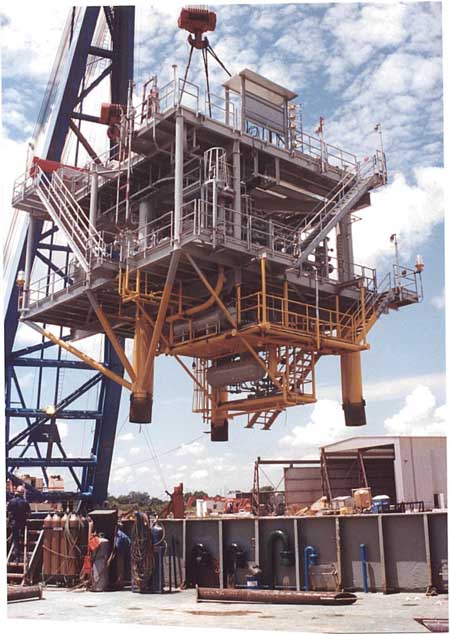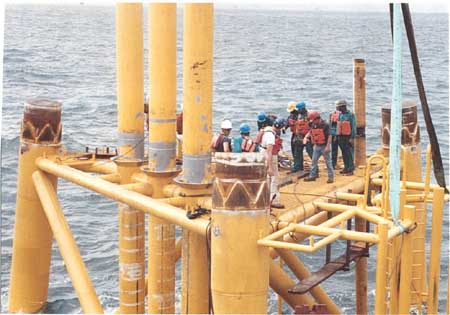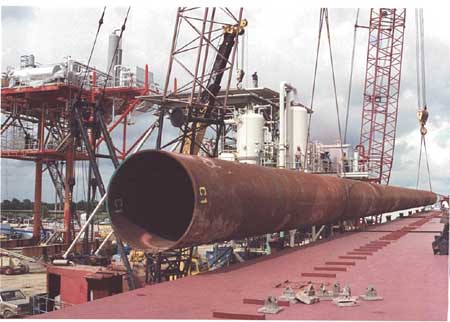Paragon Mini-Jacket Goes to Cameroon

The VEST mini-jacket is unique in that the structural frame does not extend to the mud line, giving operators increased flexibility in project planning and several cost benefits for the design, fabrication, transportation, installation and reuse of the structure, says John Barnes, Paragon project manager.

"Paragon's VEST mini-jacket has the potential to cut project costs by some 20%. This increased value provides operators an innovative approach to offshore development in water depths up to approximately 125 ft," said Barnes.
With regard to the new Elf Serepca project, Gerard Bony, Elf project manager, anticipates the new VEST technology will help compress the Boa Sud project schedule.
"I am confident we will save many weeks using the mini-jacket concept for a similar development. Importantly, there is nothing to invent. The technology is existing within the Paragon offices," said Bony.
Barnes adds that the VEST mini-jacket is ideal for the mild environmental conditions offshore West Africa and also is applicable for moderate environments in the Gulf of Mexico and Southeast Asia.
Barnes first proposed the VEST mini-jacket to Pecten for the Akono AKF1 platform in 73ft of water. Pecten initially had planned a conventional three-pile jacket, but Barnes—looking for an opportunity to improve project costs—suggested the VEST mini-jacket, using a tripod configuration.
"The seabed soils off Cameroon are very soft, making it necessary to use large, expensive mud mats to support the weight of a jacket during installation. The VEST mini-jacket eliminates the use of mud mats because the structure rests entirely on a pre-installed caisson while piles are driven through the pile sleeves," said Barnes.
He added that the center sleeve of the VEST mini-jacket's specially configured structural frame is positioned over the caisson during installation. The weight of the mini-jacket is entirely supported by the caisson during installation.
Contributing to the design effort—and cost savings—is the substantially reduced VEST mini-jacket weight, which is approximately 50 tons. By contrast, a traditional full-water-depth tripod jacket for the Akono platform would have weighed 130 tons; the Erong North jacket in 46 feet of water under conventional design would have weighed 83 tons. In terms of height, the VEST mini-jacket typically extends 15 feet above the water line and 10 feet below the water line, leaving no structural framing to rest on the sea floor.

Barnes notes, however, that Pecten had initial concerns over the feasibility of installing the VEST mini-jacket.
"Installation was our biggest challenge, but enthusiasm grew once Pecten's structural engineers reviewed and approved the design," said Barnes.
The offshore installation was a success, he explained, adding, "the structure was even more stable than expected in the midst of persistent, long-term swells and rough waters.
For the Akono platform, the caisson diameter was 48 inches; however, the design can accommodate a range of diameters, depending on site conditions. A caisson can be pre-existing in the field or specifically installed for this purpose. In instances where a caisson does not exist at a site, a caisson is installed in a conventional manner using a lift vessel or a drilling rig.
After the VEST mini-jacket installation is completed, the deck is installed on and totally supported by the piles, and wells may be drilled through the caisson and conductor slots. Outboard wells may be added; however, wells are preferably incorporated within the VEST mini-jacket. The Akono platform was designed for seven well slots: the caisson and three well slots within the jacket and three well slots outboard of the jacket framing.
Each of the VEST mini-jacket projects to date has applied a tripod configuration; however, Barnes notes that a four-leg configuration to accommodate a larger deck or additional well slots also is feasible and can be built for a fraction of the cost of a conventional jacket.
"The simplicity of the VEST mini-jacket affords operators a lot of flexibility in project planning and greater choices in the variety of fabrication/transportation options to impact scheduling and cost considerations," said Barnes.
Many smaller, local fabricators can be relied on to construct the VEST mini-jacket structure, which has jacket legs that are only 25 feet long. Meanwhile, smaller project ships or container ships can transport the structure, avoiding the traditional and costly barge and tug requirements for transporting larger structures, he explained.
Boa Sud Work Scope
For Elf's Boa Sud project 30 miles offshore in 70 feet water, Paragon is providing "economies of scale," says Lee Danner, Paragon project manager.
"We're able to apply engineering and drafting work previously completed for the Akono and Erong North developments to Elf's proposed Boa Sud development. This flexibility is critical on an aggressive fast-track project such as Boa Sud," said Danner.
Paragon is providing engineering and project management services for the fabrication, transport and installation of a four-well, 50-ton tripod VEST mini-jacket and piping to support a deck originally fabricated and installed on another platform. The work scope also includes design procedures for the removal and transport of the surplus deck for installation on the proposed Boa Sud jacket.

The surplus deck is appropriate for the newly proposed Boa Sud platform, with test facilities designed for 5,000 barrels of oil per day. Paragon has recommended some modifications to the deck to address slight differences in production parameters at the Boa Sud site.
Also planned is an eight-inch diameter pipeline, approximately 5,200 meters in length, from the Boa Sud platform to Elf's existing KCF-1 platform. Paragon is providing design and drafting for the pipeline to the KCF-1 platform. Associated activities include procedures for pipeline route survey, installation, hook-up, pre-commissioning and commissioning.
Paragon's engineering design services for Boa Sud include mechanical, process, structural, marine transport, instrument and electrical, pipeline engineering and drafting services.
Separately, Paragon is assisting with the replacement of the Akono deck to address reduced production levels. Paragon is designing a new mini-deck and minimal single-well hook-up facilities with pig launching for the Akono platform. Paragon also is providing electrical and instrument design and drawings for single-well hook-up facilities on Akono.
Paragon will prepare hook-up, pre-commissioning and commissioning procedures for both Akono and Boa Sud based on those originally developed for Akono.
The Boa Sud platform is scheduled to begin drilling in March 2000. Elf is presently requesting bids for procurement, fabrication, transportation and installation of the new tripod VEST mini-jacket and the installation of the in-field pipeline. The bid packages include associated work for the relocation of the Akono deck and the fabrication, transportation and installation of a replacement deck.
